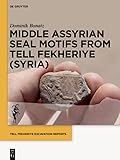Tell Fekheriye Excavation Reports. Volume 1, Middle Assyrian Seal Motifs from Tell Fekheriye (Syria) / Dominik Bonatz; ed. by Dominik Bonatz.
Material type: TextSeries: Tell Fekheriye Excavation Reports ; Volume 1Publisher: Berlin ; Boston : De Gruyter, [2021]Copyright date: ©2021Description: 1 online resource (140 p.)Content type:
TextSeries: Tell Fekheriye Excavation Reports ; Volume 1Publisher: Berlin ; Boston : De Gruyter, [2021]Copyright date: ©2021Description: 1 online resource (140 p.)Content type: - 9783110691238
- 9783110691962
- 9783110691931
- 930
- online - DeGruyter
- Issued also in print.
| Item type | Current library | Call number | URL | Status | Notes | Barcode | |
|---|---|---|---|---|---|---|---|
 eBook
eBook
|
Biblioteca "Angelicum" Pont. Univ. S.Tommaso d'Aquino Nuvola online | online - DeGruyter (Browse shelf(Opens below)) | Online access | Not for loan (Accesso limitato) | Accesso per gli utenti autorizzati / Access for authorized users | (dgr)9783110691931 |
Browsing Biblioteca "Angelicum" Pont. Univ. S.Tommaso d'Aquino shelves, Shelving location: Nuvola online Close shelf browser (Hides shelf browser)

|

|

|

|

|

|

|
||
| online - DeGruyter Christ’s Enthronement at God’s Right Hand and Its Greco-Roman Cultural Context / | online - DeGruyter The Early Reception of the Torah / | online - DeGruyter Deathworlds to Lifeworlds : Collaboration with Strangers for Personal, Social and Ecological Transformation / | online - DeGruyter Tell Fekheriye Excavation Reports. Volume 1, Middle Assyrian Seal Motifs from Tell Fekheriye (Syria) / | online - DeGruyter Perspectives on Element Theory / | online - DeGruyter Wissenschaftliches Arbeiten / | online - DeGruyter Human and Technological Progress Towards the Socio-Economic Paradigm of the Future : Part 3 / |
Frontmatter -- Table of Contents -- Preface -- 1. Introduction -- 2. Tell Fekheriye in the Khabur Headwater Region: The Geographic and Historical Setting -- 3. The Reconstruction of the Seal Motifs of Tell Fekheriye -- 4. Style and Iconography of the Tell Fekheriye Seal Motifs -- 5. The Archaeological Context of the Tell Fekheriye Seal Impressions -- 6. Objects with Seal impressions, Sealing Practices and their Functional Contexts -- 7. The Use of Seals in Tell Fekheriye: Political, Economic and Social Implications -- 8. Comparision Catalogue -- 9. Bibliography -- 10. Arabic Summary
restricted access online access with authorization star
http://purl.org/coar/access_right/c_16ec
Despite ongoing interest in Middle Assyrian glyptic art, the publications of Middle Assyrian seals and seal impressions from excavated sites in the Near East are very rare. The book is the first to offer a comprehensive study on the seal corpus from an archaeological site historically located in the western territory of the Middle Assyrian state. The seal impressions and few original seals, which were found during the excavations in Tell Fekheriye (Syria), substantially add to our understanding of the iconographic repertory and the use of seals in the Middle Assyrian period. The corpus dates to the reigns of the Assyrian kings Shalmaneser I and Tukulti-Ninurta I in the 13th century B.C. It documents practices of governance and administration in the growing Middle Assyrian Empire, points to activities of high-ranking Assyrian officials and unfolds the pictorial reality of political and ideological intensions. While finding detailed information on unpublished materials, their archaeological contexts and interpretations, the reader is also invited to follow a discourse on art, state and society for which the Middle Assyrian seal motifs from Tell Fekheriye provide an excellent case study.
Issued also in print.
Mode of access: Internet via World Wide Web.
In English.
Description based on online resource; title from PDF title page (publisher's Web site, viewed 01. Dez 2022)


